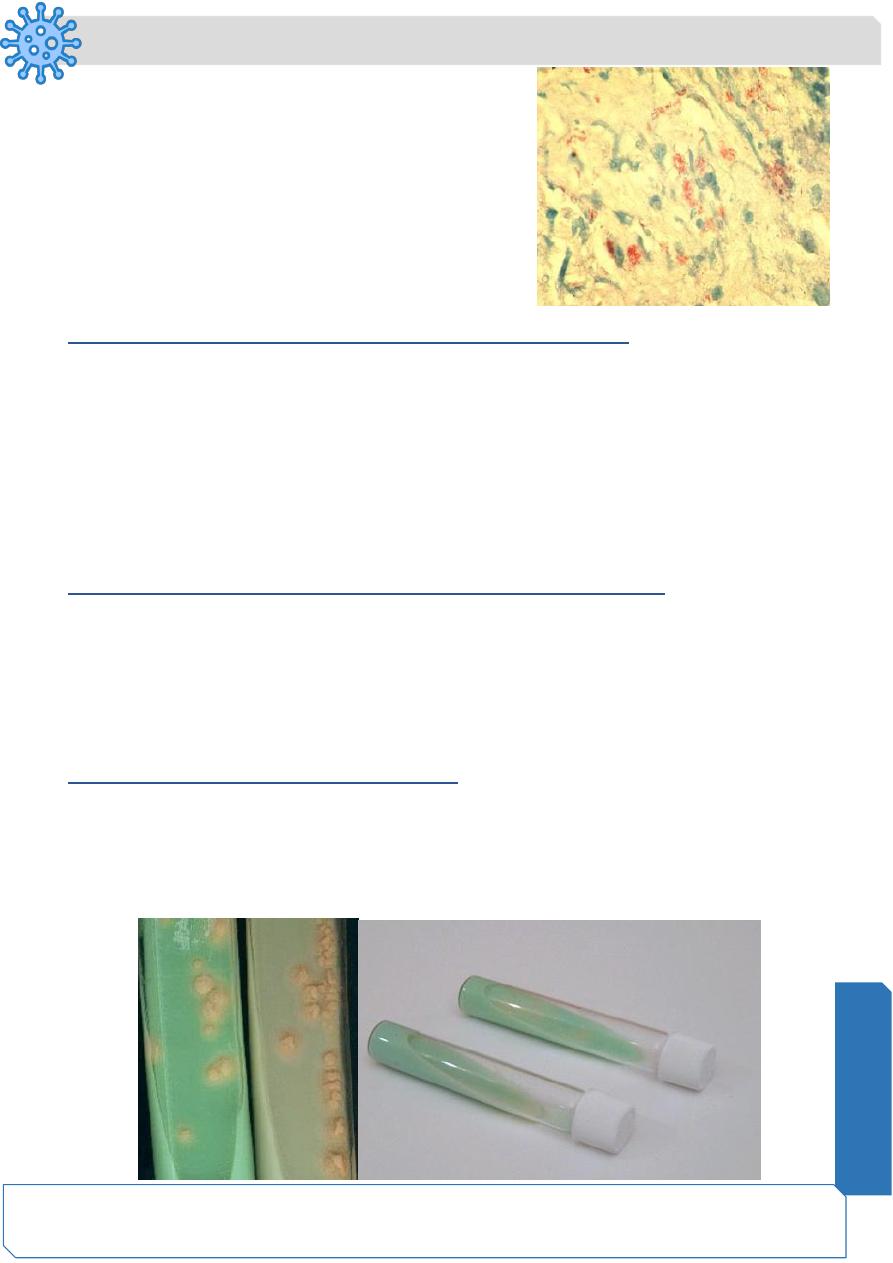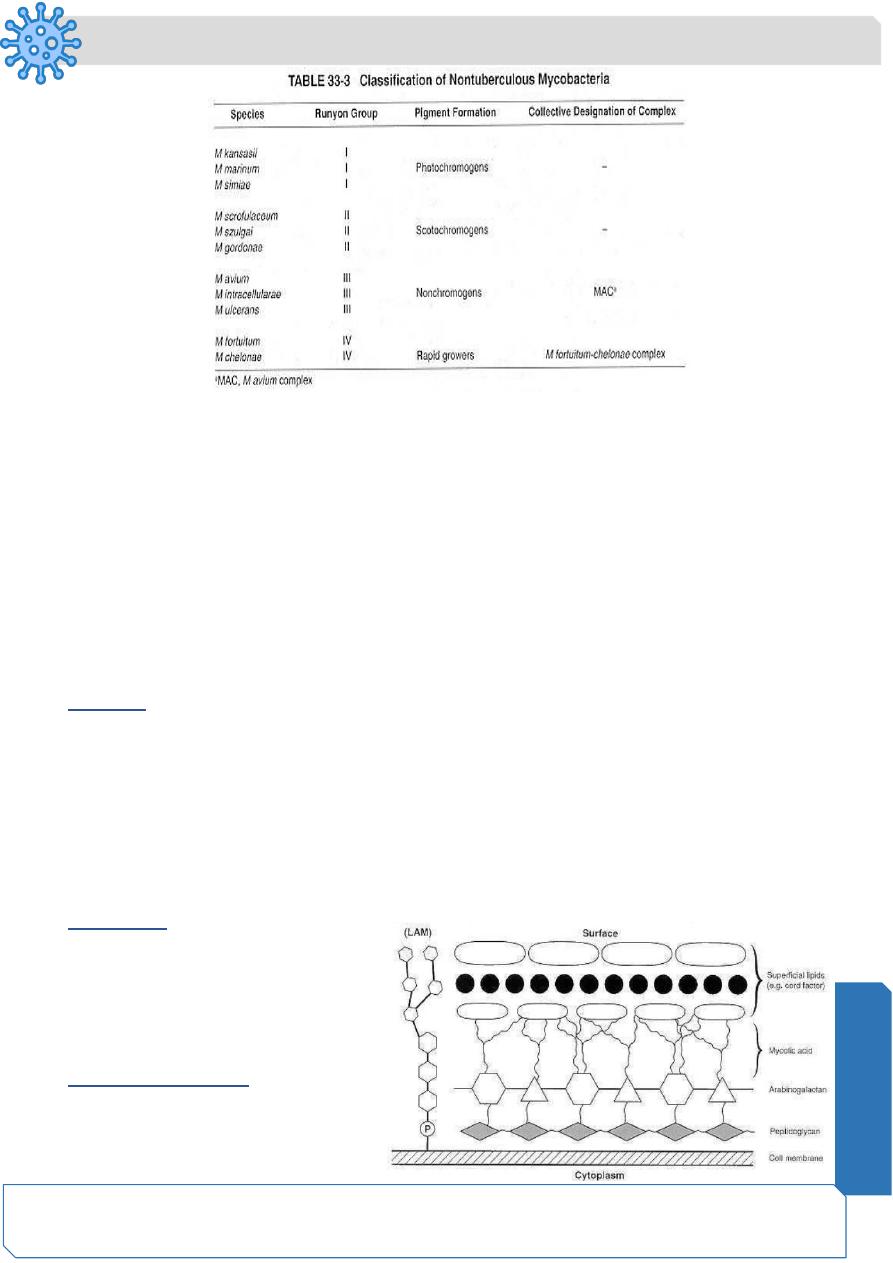
Microbiology
Notes…
1
Mycobacteria
Mycobacterium:
❑ This genus contain numerous species, cause a wide variety of chronic infections in
humans.
❑ Two most important diseases :
a- Chronic lung infection T.B. (Tuberculosis).
b- Disseminated infection leprosy.
❑ Members of this genus retain dye (carbol fuchsin stain) even after decolorization with
acid alcohol so member of this genus called acid fast bacilli.
❑ Mycobacteria can not stained with Gram stain need special staining method call Acid
fast stain.
Classification of Mycobacteria:
Mycobacteria can be classified as :
I-Mycobacterium tuberculosis complex:
1- Mycobacterium tuberculosis.
2- Mycobacterium bovis.
3- Mycobacterium africanum.
Tuberculosis in human mainly caused by M. tuberculosis, human infection can also
caused by M. bovis (from cattle), & M.africanum (from monkey).
II-Mycobacterium other than tuberculosis:(MOTT)or tuberculoid bacilli (atypical
mycobacteria):
(1) M.avium-intracellularcomplex.
(2) M. kansasi.
(3) M. scrofulaceum.
(4) M. marinium, M. ulcerans.
1 - M.avium-intracellularcomplex:
❑ Widely present in the environment & animals (birds).
❑ Opportunistic infection in immunosuppressed patients.
❑ Lungs 1ry affected, can spread to other organ, cause disseminated infection as
in AIDS patients.
❑ Resistant to 1st line antituberculous drugs, a combination of drugs used for
treatment (new macrolides + ethambutol).

Microbiology
Notes…
2
2- M.kansasi:
❑ Reservoir possibly wild or domestic animals.
❑ Low or absent communicability.
❑ Pulmonary & systemic disease indistinguishable from tuberculosis specially in
patient with impaired immunity.
❑ Susceptible to the usual antituberculous drugs.
3-M.scrofulaceum:
❑ Found in moist soil.
❑ Cause chronic cervical lymphadenitis mainly in children & rarely cause other
granulomatus disease.
❑ Surgical excision of the involved L.N. may be curable.
❑ Resistance to antituberculous drug are common.
4- M.marinium, M.ulcerans:
❑ Found in water, grow at 31
C.
❑ Cause superficial skin lesion( ulcer or swimming pool granuloma).
❑ Surgical excision, tetracycline, rifampicin, ethambutol are sometime effective.
III-Rapid growers :(M.fortuitum-chelonaecomplex):
❑ Free living found in soil,& water.
❑ Rapid growing (3- 6 days).
❑ Rarely cause disease in human.
❑ Resistant to antituberculous drugs, respond to amikacin, deoxycycline, cefoxitin,
erythromycin & rifampicin.
IV- Saprophytic Mycobacterium:
❑ Free living & not associated with human disease.
❑ (1) M.pheli.,(2) M.gordonae.(3) M. smegmatus.
❑ 1 st two species present in plants ,water, soil, while the 3rd one present in the
sebaceous secretion of human.
V- M. leprae:
Strict pathogens cause leprosy & can't be cultured in vitro.
M.tuberculosis Microscopical appearance:
Ziehl-Neelsen technique used for the identification of
acid fast bacteria.
Tubercle bacilli appear red slightly curved slender rods
(2-4 µm & 0.2-0.4 µm) over a blue background.
Either appear as discrete rods or as aggregating, long

Microbiology
Notes…
3
arrangements, called serpentine cords in which the
bacilli aggregate with their long axis parallel.
Only virulent strains arranged in serpentine cords.
Cultivation of mycobacteria:
1- Agar based media [Middle brook 7H10, Middle brook7H11]
➢ Contain defined salts, vitamins, co-factors, oleic acid, albumin, glucose, glycerol & in
7H11 in addition contain casein hydrolysate.
➢ Used for:
1- Observation of the colonies morphology.
2- Susceptibility testing.
3- With added antibiotics used as selective media.
➢ These media are less sensitive for 1ry isolation of mycobacteria.
2- Egg-based media: [Lowenstein Jensen medium (L-J medium)]
➢ Contain defined salts, glycerol & complex organic material (fresh eggs, egg yolks,
potato flour) & others in various combinations.
➢ Malachite green included to inhibit other bacteria.
➢ With added antibiotics are used as selective media.
➢ Used for 1ry isolation of mycobacterium .
3-Broth media: [Middle brook 7H9 & 7H12]
➢ Used for biochemical tests.
➢ Middle brook 7H12 medium, growth detected automatically by the presence 14 'C-
palmitic acid, mycobacteria grow utilize radio labeled carbon & releasing 14 'CO2 which
detected by the machine, by this positive culture can be detected in 2 weeks.

Microbiology
Notes…
4
Growth characteristics, growth rate & colony morphology :
❖ Obligate aerobes.
❖ ^ CO2 tension enhances growth.
❖ Growth rate much slower than most bacteria.
❖ Need prolong incubation at 37 °C up to 8 weeks.
❖ Saprophytic mycobacteria tend to grow more rapidly,& in less than one week.
Growth rate :
1-Rapid growers need < 7 days to grow.
Free living saprophyte mycobacteria
M.fortuitum-chelonaebelongs to this group.
2-Slow growers need >7 days to grow.
M.tuberculosis:
▪ Need 2-3 weeks to grow.
▪ Growth describe as tough, rough, creamy colored, easily detach from the
surface of media, difficult to emulsify.
▪ This growth characteristics (Eugonic growth) .
M.bovis:
▪ Need 5-6 weeks to grow.
▪ Smooth surface, adhere to the surface, & easily emulsify.
▪ Growth describe as (Dysgonic growth).
Mycobacterium other than tuberculosis (MOTT) or tuberculoid bacilli can be
differentiated according to the pigment production in relation to the light exposure into:
Photochromogens:
Give pigmented growth after prolong exposure to the light this
pigment vary from lemon yellow to bright orange
(M.kansasi M.marinum, M.simiae).
Scotochromogens:
These mycobacteria are pigmented in the dark usually deep yellow
to orange which darkens to an orange or red after exposure to light.
(M.scrofulaceum, M.szulgai, M.gordonae).
Nonchromogens:
These mycobacteria don’t
develop pigment on exposure to light.
(M.avium-intracellularcomplex, M.ulcerans).

Microbiology
Notes…
5
Reaction to physical & chemical agents:
➢ Mycobacteria more resistant to chemical agents due to the hydrophobic nature of the
cell surface & their clumped growth.
➢ Dyes (e.g. malachite green) or antibacterial agents (e.g. penicillin) can be
incorporated into media without inhibiting growth of tubercle bacilli.
➢ Mycobacteria can survive in acids & alkalis, this can be used to decontaminate the
clinical specimens from other contaminating m.o.
➢ Tubercle bacilli are resistant to drying & survive for long periods in dried sputum.
Constituents of tubercle bacilli:
A-Lipids
:rich in lipids in forms of: Mycolic acid (long chain fatty acids C78-C90),
Waxes, Phosphatides.
• High lipid content of cell wall responsible for the acid fastness & inability of the
mycobacteria to stain by Gram stain.
• One type of the mycolic acid trehalose dimycolate (cord factor) responsible for:
1-Characteristic growth of virulent strains. (serpentine cords).
2-Inhibit migration of leukocytes, causes chronic granulomas.
B-Proteins
: each type of
mycobacterium contains several
proteins that elicit the tuberculin
reaction. They can also elicit the
formation of a variety of antibodies.
C-Polysaccharides:
Mycobacteria
contain a variety of
polysaccharides, induce immediate
type of hypersensitivity
